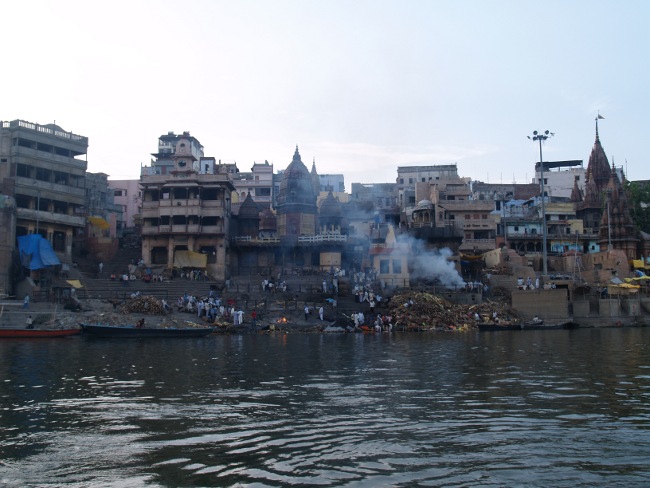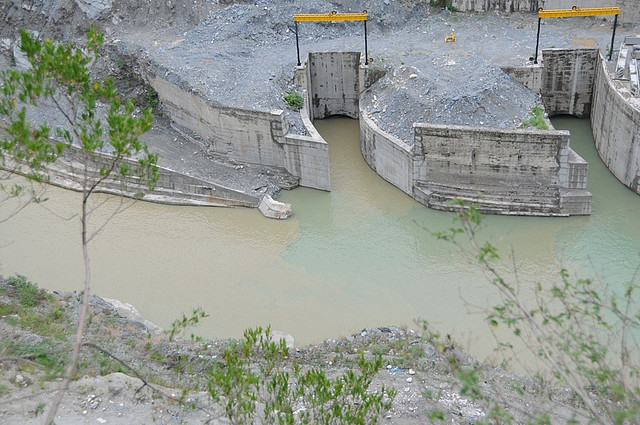True to the promises made during election campaigning, Narendra Modi, India's 15th Prime Minister announced measures to clean up the Ganga as soon as he assumed office. A new Ministry in charge of river issues has been created. Originally the 'Ministry of Water Resources', it will now be called the 'Ministry of Water Resources, River Development and Ganga Rejuvenation' headed by Uma Bharti. How much this will help the Ganga, however, is a matter of speculation.
Ganga clean-up became an election issue when Modi decided to contest from the pilgrim town of Varanasi. "Mother Ganga needs someone to take her out of this dirt and she’s chosen me to do the work", announced Modi after his victory. Media reports are rife with how the new Prime Minister plans to clean up the Ganga on the lines of the Sabarmati in Ahmedabad. Nitin Gadkari, the Road Transport and Highways and Shipping minister has even shared his plan to use the river for internal transport. "It is my dream to restore the sacred Ganga’s glory and utilise this ancient river’s full potential by using it as a waterway from Gangotri to Kanpur and Kanpur to Patna to transport cargo and man", he told the media as soon as he took charge of the Ministry.
The Tourism Ministry has also announced the revival of a 2012 plan to upgrade the Ghats in Varanasi. The Rs. 18-crore plan involved building jetties, improving lighting on the ghats, repainting garish hotel walls with aesthetic colours, improving signages, reconstructing the steps with red sandstone, have bathing spaces and changing rooms and removing the mesh of overhead cables and ugly advertisements. The plan, which was defunct for two years, is now interesting corporates, including major hospitality chains, who want to invest in the renovation work, thanks to the MP of Varanasi, Modi.
No clear mandate
Despite all these plans by other Ministries, the mandate of the 'Ganga Rejuvenation Ministry' however, is not yet clear and environmentalists do not have much hope from it.
"To begin with, the Ganga rejuvenation task seems to be a part of the Water Resource Ministry. And from the track record of the Ministry, we know that they have no concern and understanding of rivers. They only know about dams", said Himanshu Thakkar of South Asia Network on Dams, Rivers and People (SANDRP). Thakkar also advised caution on the use of the term "River Development" as a river is an ecological entity.
"Does it mean development of areas around the river and betterment of people living around it or simply more dams or even interlinking of rivers? Since the new Prime Minister was very vocal in his support both for river interlinking and dams during his election campaigns, we have doubts about the Government's intentions", he said.
Some key Ministries which affect rivers profoundly include, among others, the:
- Ministry of Water Resources
- Ministry of Environment and Forests
- Ministry of Power
- Ministry of Urban Affairs
- Ministry of Rural Development
- Ministry of Home Affairs (Disaster Management)
- Ministry of Agriculture, Department of North East Region
- Ministry of Non Conventional Sources of Energy
How is this new proposed Ministry going to coordinate with these other Ministries? Moreover, according to India’s constitution, rivers are essentially state subjects and no state is likely to welcome such an infringement from the Centre into what the states see as their domain of responsibility.
Failure of existing plans
It is not the first time that attention has been drawn to the cleaning of the Ganga. Rs. 27,000 crore have been spent till date under the Ganga Action Plan, which involves the development of sewer networks, sewage treatment plants, electric crematoria, community toilets and river fronts in Uttarakhand, Uttar Pradesh, Bihar and West Bengal. However, the plan has not yielded the desired results.
Anupam Mishra of the Gandhi Peace Foundation, widely known for his work on water conservation, feels that the new Ministry should consider what solutions they want- behaviour based changes or technological solutions.
"Everybody needs water from the Ganga- agriculture, industry, towns, etc. Does the Ganga have that much water? With technological solutions like STPs, we have not been able to clean the Yamuna even in Delhi where the maximum number of STPs are located because using STPs requires electricty, which has an added cost. Another option they usually take up is to divert the polluted water to a nullah. So there will be two parellel rivers flowing, one with lesser and lesser clean water for our needs and another with more and more polluted water", said Mishra.

Talking about the importance of behaviour-related changes towards the river, Mishra said that the Rs. 18 crore allocated for the Ghats can modernise the banks in Varanasi but it will not really change anything for the river. "For instance, the cow comes to the river because she gets food there and leaves dung on the banks. If one has to prevent the cow from coming near the river to prevent litter on the riverbed, they will have to provide food for her somewhere else. So everything is interlinked", he says.
In 2009, the Ganga was declared a national river and the then Prime Minister Manmohan Singh set up the National Ganga River Basin Authority. Even five years after its constitution, the Authority has failed to make a significant change. Similarly, ecologists have slammed the Ganga River Basin Management Plan that an IIT consortium is working on terming it to be pathetic in its understanding of the river and that it simply promotes privatization. "Another project in the name of Ganga, national or local, is not the need of the hour. What we need is a new approach to river governance, which is based on ecological, and not engineering principles, which is participatory, and not exclusive and which is democratic and not autocratic", said Thakkar.
The Sabarmati Model
The BJP says that it will clean up the Ganga in Varanasi the way it has cleaned up the Sabarmati in Ahmedabad. Ecologists, aware of the work on the Sabarmati, oppose this. The water flowing through the Sabarmati in its 10.4 km stretch in the city of Ahmedabad is actually the water of the Narmada River diverted into Sabarmati. This water was originally meant for Kutch, Saurashtra and North Gujarat, they claim. Upstream of the Sabarmati, from the point where the Narmada main Canal releases water into it, the river is dry. "And if one goes down to the Vasna barrage, downstream of Ahmedabad along the Sabarmati, one can easily see the polluted river", says Thakkar.
"One could divert Narmada water into Sabarmati, because it is a small river. But if this model needs to be followed for a huge river like the Ganga, one will need to bring water from the Brahamputra. The cost of pumping water from the Narmada into the Kshipra river, the latest river interlinking project, is Rs. 16 lakh per day. One can imagine the cost if water has to be diverted into the Ganga. Is it sustainable?", he asks.
The stand on dams Swami Dayanand of Matri Sadan Ashram in Haridwar, which has been protesting sand mining in the Ganga for many years, said that if the Government is really keen on doing something, they should begin with implementing the recommendations of the MoEF's Committee on dams.
Swami Dayanand of Matri Sadan Ashram in Haridwar, which has been protesting sand mining in the Ganga for many years, said that if the Government is really keen on doing something, they should begin with implementing the recommendations of the MoEF's Committee on dams.
The Committee was constituted on the orders of the Supreme Court after the floods in Uttarakhand last year. Headed by Ravi Copra, Director of the People's Science Institute, Dehradun, the Committee recommended that atleast 23 dams on the Ganga and its tributaries should be dropped. It further said that hydropower projects played a significant role in the Uttarakhand disaster and that there is urgent need to improve the environment governance of hydropower projects. Due to environment degradation from the dams, the young Himalayan mountains have been rendered weak. Events like cloudbursts and landslides that happened earlier also now wreak havoc, it said.
"Even to keep the river clean, it is common knowledge that it should be allowed to flow, uninterrupted. It will clean itself if it has enough water. If the source of the river is trapped, how does the Government intend to clean the river?", said Mallika Bhanot of the NGO Ganga Ahvaan.
To add to this, an announcement about speedy clearances by the new Environment Minister Prakash Javedkar has made environmentalists wary. "In all their rhetoric about cleaning the Ganga, there has been no mention about the dams, which makes one suspect whether the new Government will do anything worthwhile," said Swami Dayanand.
"Uma Bharati, the minister incharge of the Ganga, has come to Uttarakhand several times and even raised the issue about dams earlier, so it is not that they are not aware of the situation. If they still feel the need, they should consult the activists working for the Ganga when they prepare their plan. Dreams like using the river as waterway will remain dreams if there is no water in the river. To be very clear, the Government's stand on the dams will prove their intentions about what they actually want to do for the Ganga", he said.
The way forward
Technological solutions to clean the river will only lead to more expenditure and thus, more GDP, but it will not clean the river, claim ecologists. What the Government really needs to start with is an understanding of what is a river.
"They need to get a sense of what are a river's functions along the various stretches during various periods, including social, ecological, economic, hydrological, geo morphological, biodiversity-related, groundwater-related and most importantly, livelihoods-related functions", said Thakkar.
Lead image source: Patrick Barry
Funeral at the ghats source: Steve Hicks













